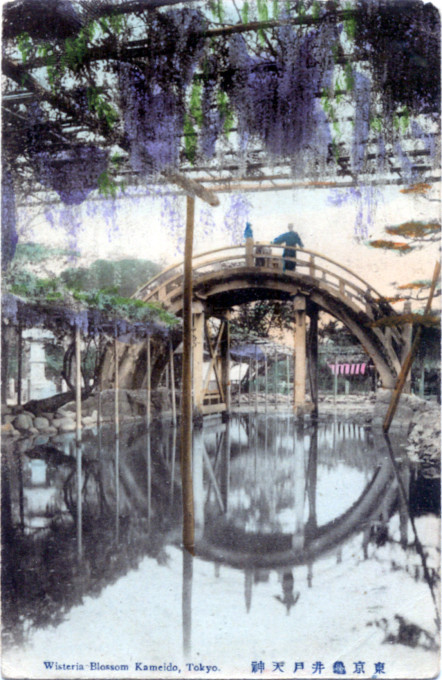See also:
Kameido Tenjin Shrine
“A ninth-generation descendent of the famous minister, Sugawara Michizane, who was a model of loyalty to the sovereign and ancestor of the Maeda daimyo families, decided to found in Hongo (the present-day Kotoku district of Tokyo) a shrine dedicated to the sage Tenjin (‘heavenly man’). There were already in Edo, as in Kyoto, several Tenjin shrines: Ieyasu, for example, had founded one near the castle. The new shrine was built in 1662 and was called Kameido [‘tortise well’] Tenjin, named for the stone tortoise seated on a well on the grounds.
“Kameido became famous for its garden with a lake crossed in the middle by a series of semi-circular bridges in the manner of the Dazai temple in Kyushu, where Michizane died in exile. These bridges shaped like half-circles were difficult to cross, but they probably had a symbolic meaning and were a great amusement to visitors.
“The principal attraction was the wisteria with its abundant and beautiful flowers which surrounded the lake. People went from all over Edo to view the wisteria at Kameido; they would sit beneath the trellis-work of flowers talking and sipping tea or sake and, as frequently happened at such popular places, houses of prostitution opened nearby.
“In the garden under a straw roof a stone ox recalled the rustic mount used by the sage in ancient times. Passers-by threw pieces of money onto the ox and if [the coins] stayed on the back of the ox it was a sign of good luck.”
– The Shogun’s City, Noel Nouet, 1990
“Kameido Tenjin Shrine is perhaps most well-known for two things: its famous arched ‘drum bridge’ and the purple wisteria, planted during the Edo period, which overhang much of its ponds from overhead trellises. The wisteria begin blooming all at once in late April. The lovely lavender-colored flowers are comprised of several bunches, and are especially beautiful when dangled from wisteria trellises. Beneath the wisteria is a quiet pond, creating a reflection of purple flowers onto the surface of the water.
“The spacious grounds of Kameido Shrine are dedicated to the 9th century scholar, poet, and politician named Sugawara Michizane. Although of the ministerial rank, Michizane was later victimized by the Imperial Court and was exiled to the southern Japanese island of Kyushu where he soon died. Shortly thereafter, several natural disasters struck the capital city, Kyoto, and people believed Michizane had come back to haunt his former enemies in the form of a vengeful spirit. He soon became identified with the Thunder God [Raijin], but later more correctly was thought of as a god of learning and literature.
“The Kameido Shrine of Tokyo itself dates to 1662, when a statue of Michizane made from plum wood (Michizane’s favorite tree) was installed here in his honor. Since then, Kameido has remained a popular destination for Japanese worshippers. Records indicate that both Tsunayoshi, the fifth Tokugawa shogun, and Yoshimune, the eighth shogun, visited this shrine. The legendary wisterias are also the subject of many ukiyo-e (color prints) and other works of art.
“To collectors and admirers of Japanese woodblock prints, Kameido Shrine is also well known. Although dozens of Japanese artists have produced drawings and prints of Kameido, it is without doubt that Ando Hiroshige’s is certainly the most well known.”
– Wikipedia
- Kameido Temple, c. 1910.
- The Drum Bridge at Kameido, c. 1910.
“‘Kameido’, with its Shrine and Wistaria Garden, in Honjo-ku, in a tawdry neighborhood near the N.E. outskirts of the city, should be visited in late April or early May, as the wistaria usually begin to droop about the end of the first week in May.
“… The small temple grounds stand in the midst of a sea of low native houses whose surroundings are without inter est. The narrow thoroughfare leading to the entrance terminates in a handsomely carved gateway in the natural wood, adorned with shishi, fishes, birds, dragons, and wave-patterns.
“Just within the enclosure is a locally celebrated Drum Bridge (Taiko-bashi), a time-worn structure over whose high hump devotees climb (risky with high-heeled shoes) as an act of special devotion to the divinity to whom the shrine is consecrated. Ladies usually elect to approach the shrine along the picturesque pathways at the right and left of the pond. Beyond the first bridge is a second smaller one facing an attractive eight-roofed gate surmounted by sculptured dragons, turtles, and phoenixes. At the foot are stone Dogs of Fo, and behind them, in glassed-in cages, are carved and painted gods in the guise of zuijin, or the ancient guards of nobility.
“The grounds are laid out in imitation of those in which Sugawara Michizane, to whom the shrine is dedicated, lived and died in exile (in Kyushu). The pond is called Shinji-no-ike, or ‘Pond of the Heart, ‘because of its fancied resemblance in shape to this organ. The name Kameido is said to be derived from kamei (lit., sitting like a tortoise, with the feet spread out behind), wherefore the big stone tortoise which the visitor will note a few yards to the right of the temple. Some pretty bridges span the narrowest parts of the pond, and many graceful trees overshadow it.
“During the [wisteria] season many flower-loving Japanese sit on the broad platforms extending out from the tea-houses to enjoy the scene. Along the walks are many tiny shops where artificial flowers made in the form of wistaria hair-ornaments, metal turtles, tiny hand- painted porcelain cups (attractive souvenirs, 10 sen each), and other gewgaws are sold.”
– Terry’s Japanese Empire, T. Philip Terry, 1914









Pingback: Kameido Tenjin Shrine, c. 1910. | Old Tokyo